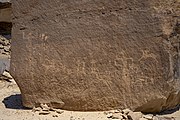Bir Hima Rock Petroglyphs and Inscriptions
 Petroglyph at Bir Hima in Saudi Arabia | |
| Location | Najran, Najran Province, Saudi Arabia |
|---|---|
| Coordinates | 18°14′55″N 44°27′06″E / 18.24861°N 44.45167°E |
| Site notes | |
| Ownership | Department of Antiquities, Saudi Arabia |
| Official name | Ḥimā Cultural Area |
| Type | Cultural |
| Criteria | (iii) |
| Designated | 2021 (44th session) |
| Reference no. | 1619 |
Bir Hima (
It was designated as part of the Hima Cultural Area UNESCO World Heritage Site in July 2021.[5]
History
Ancient history of human occupation of this habitat is credited to its resources of wild life, water and the limestone terrain.
Findings
Bir Hima, which is an ancient Palaeolithic and Neolithic site, lies north of Najran, categorized as a
Bir Hima, as part of Najran, is a treasure trove of petroglyphs, eclipsed only by those found in the Jubba region. Here, 100 sites have been identified. In the Najran area, as many as 6,400 human and animal illustrations, which include more than 1,800 camels and 1,300 human depictions, have been recorded.
Gallery
References
- ^ Harrigan, Peter; Bjurström, Lars (February 2002). "Art Rocks in Saudi Arabia". saudiaramcoworld.com. Archived from the original on 8 July 2011. Retrieved 17 April 2011.
- ^ a b c "Ring of Naharit". Thye Archaeology Fund. Archived from the original on 12 June 2003. Retrieved 18 April 2011.
- ^ "Bir Hima rock petroglyphs in Saudi Arabia's Najran include image of camel". Al Arabiya. 19 April 2021.
- ISBN 978-0-306-46262-7. Retrieved 17 April 2011.
- ^ "Hima Cultural Area in Saudi Arabia inscribed on UNESCO World Heritage Site list". Xinhua News Agency. 24 July 2021. Retrieved 24 July 2021.
- ISBN 978-81-85492-09-4. Retrieved 17 April 2011.
- ^ "Art rocks in Saudi Arabia". Saudiarmaco world. Archived from the original on 27 August 2004. Retrieved 17 April 2011.
- ^ a b "Introduction to Saudi Arabia Rock Art and Petroglyphs" (PDF). Ancient cultures.info. pp. 30–37. Retrieved 17 April 2011.
- ^ "An Archeaological Study Tour of The Kingdom of Saudi Arabia". Archaeological Tours. Archived from the original on 17 September 2010. Retrieved 17 April 2011.
- ISBN 978-0-04-445900-2. Retrieved 17 April 2011.
- ISBN 978-1-84511-116-8. Retrieved 17 April 2011.
- ^ Robert G. Bednarik, SCIENTIFIC INVESTIGATIONS INTO SAUDI ARABIAN ROCK ART: A REVIEW, Mediterranean Archaeology and Archaeometry, Vol. 17, No 4, (2017), pp. 43-59 (p.49)







